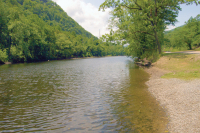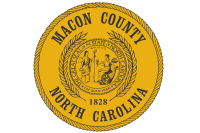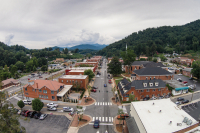New TDA make-up leaves questions unanswered
By Julia Merchant • Staff Writer
New legislation to restructure the Haywood County Tourism Development Authority calls for a drastic overhaul of the organization while leaving much open to interpretation.
The overhaul was prompted by controversy over the TDA’s budget, particularly a new marketing plan that was unveiled in 2005. The marketing plan was devised after lodging tax revenue — a 3 percent tax on overnight stays at lodging facilities — started declining three to four years ago. The TDA wanted to fund new marketing initiatives in hopes of turning things around.
To do so, it took money away from festivals and events, as well as contributions it historically made to help the Haywood and Maggie chambers of commerce run their visitor centers. The sudden cuts to festival funding caused an uproar, which led to the changes coming down the pipe today.
A task force appointed by county commissioners recommended some of the changes. Others were developed by commissioners themselves.
In the past two years, tourism in Haywood County has rebounded — occupancy tax revenue was up 7 percent in 2006. By many accounts, the most recent TDA board was running smoothly, and some questioned whether a major overhaul was still necessary. Those questions mean little now, however, since the legislation has already passed.
Related Items
No action has been taken by county commissioners to enact the changes.
The new board make-up
One of the big changes the new legislation calls for is a new board make-up with broader representation.
Then: The old TDA consisted of nine members. Six, or two-thirds, had to be from lodging businesses. The remainder had to be from tourism-related businesses, such as attractions, art galleries or restaurants.
Now: The new TDA will have 12 members. Only half must be from lodging businesses. Two must be from tourist-related businesses. Four additional members will be recommended by each town — Waynesville, Clyde, Maggie Valley and Canton — in Haywood County. They can be from any walk of life, not necessarily the tourism industry.
County commissioners will decide whether to keep members of the existing board and add members or start over completely and make current board members reapply for their seats.
More hands in the pie?
Three new members are being added to the TDA. Obviously, any time more opinions are brought to the table, the more room there is for differing views.
“The more people you have, the more different opinions you’ll have,” said TDA Executive Director Scotty Ellis.
Motel owner and board member Ken Stahl, though, is optimistic about the changes.
“You’ve got a few more eyes and a few more brains involved in it, and that’s probably a good thing,” he said.
Some TDA members think the addition of new people will have a negative effect. Board member Tom Halsey, owner of the Herrin House Bed and Breakfast in Waynesville, says the addition of new members is offensive to the TDA.
“It’s almost an insult to the collective wisdom of the board to have ‘x’ number of people added,” he said.
Halsey worries that advancements over the past two years will be for naught, since more fingers will now be in the pie trying to get the TDA’s money.
“You’re going to have 15 new people espousing their views and voting on where the funds go, and I just see that as a recipe for losing what we’ve gained,” he said.
Lodging loses majority
With the new board, lodging owners will no longer make up a majority of the TDA. The new legislation requires that just half the voting members of the board be affiliated with hotels, motels or bed breakfasts — the entities that collect the tax.
Though previous TDA Chair Alice Aumen, owner of Cataloochee Ranch, is optimistic about some of the changes, this is one she doesn’t like.
“I disagree with that. I think if we’re going to be collecting the tax, I think there would be more representation in that industry,” she said.
Mike Nelson, owner of Abbey Inn and Motel in Maggie Valley, agrees that lodging owners having a majority was only fair.
“That’s deserving, since we are the ones that have to collect (the tax) and increase the price of our product,” Nelson said, referring to the increase in the occupancy tax from 3 to 4 percent that accompanied the legislation.
Lodging owners didn’t just lose their majority. The new legislation also allows for members not directly affiliated with any tourism-related business, like bankers or car mechanics, to serve on the board.
Stahl is hopeful that even though these people are not operating businesses directly related to tourism, they won’t lose sight of what is best for TDA dollars.
“Whether you’re on there as a lodging owner or doctor or lawyer, you still see the logic of where it needs to go,” he said.
Town appointments
The other major aspect of the new board makeup is that each of the county’s four towns get to recommend one person to serve on the TDA. On a positive note, the towns could bring a fair representation to all parts of the county on a somewhat equal level. Stahl points out that now all municipalities will have a say.
On the other hand, town appointments could lead to TDA members looking out for the interest of their specific town rather than the county as a whole. Aumen worries that could lead to problems.
“We denoted a code of ethics and conduct adopted into our bylaws last year that kind of precludes anyone becoming very self-serving, but whether they become territorial, it depends on their personalities,” she said. “I think we’re all here as the TDA, and I hope people keep that in their vision.”
What defines tourism?
One last change in the legislation allows the TDA more freedom in how it spends its dollars.
Then: The old legislation required occupancy tax revenues to be spent on tourism promotion. This included advertising or marketing an area or activity, publishing pamphlets and other materials, conducting market research, and any other activities designed to attract tourists to the area.
Now: Only two-thirds, or 67 percent, of occupancy tax revenue must be spent on tourism promotion. The remainder can go toward “tourism-related expenditures,” the definition of which is vague.
The clause “tourism-related expenditures” leaves it up to counties to decide what that actually constitutes. The clause was partially intended to make sure festivals and events got their fair share of dollars. Before, the TDA funds could only be used to advertise and promote a festival. They could not be used for the upfront costs of throwing a festival, like hiring entertainment or renting port-a-potties. But now, festival organizers will have more lee-way to pay for these things under “tourism-related expenditures.”
The definition, though, leaves a lot open to interpretation. Where exactly should the line be drawn? Maggie Valley, for example, has broached the idea of using TDA money to put in lights at its festival grounds. Since recreational events can bring people to the county, should tourism dollars be spent on soccer fields?
“In some of the other counties, they built boat docks because there are a bunch of fishing tournaments. (The clause) is rather subjective, but if it’s a tourist-related situation that’s within the guidelines currently being looked at, then it’s OK,” Stahl said.
Nelson disagrees wholeheartedly with the vague definition.
“The whole purpose of the occupancy tax since 1983 was to promote tourism aspects of Haywood County. Taking the money the way they’re doing with all the vagueness is horrible, and taking it away from tourism-related people sucks,” Nelson said.
Dividing the increase
The legislation also guarantees funding for festivals and special projects — addressing the root cause of the initial uproar that prompted the changes. Under the new law, the occupancy tax will increase from 3 to 4 percent.
The money from the extra 1 percent — projected at roughly $230,000 — will go into “five separate accounts based on the collection area” where the tax was collected. Canton, Clyde, Maggie Valley, Waynesville, and Lake Junaluska are each considered “collection areas.” They will each get back whatever percentage of the 1 percent increase is generated by businesses in their zip codes.
The legislation guarantees a pot of money be spent on projects in each geographic district, but the TDA gets final say over which projects.
The idea resembles an old method of so-called “corridor funding” that the TDA practiced before it was found to be in violation of existing laws. The essential concept is that the towns raking in more of the occupancy revenues will get a portion of that money back.
The Maggie Valley area rakes in 60 percent of the total occupancy tax revenues. the Waynesville area is next with 28 percent; the Canton area follows with 8 percent; and Lake Junaluska and Clyde bring in around 1 percent each.
Maggie Valley Mayor Roger McElroy lobbied hard for this piece of the legislation. He says its only fair that since Maggie rakes in the majority of the occupancy tax revenues, they should get a higher percentage of the tax increase.
McElroy says with the extra funds, Maggie will be able to add festivals and promote attractions like Ghost Town, Wheels through Time and Eaglesnest Entertainment.
“The old corridor funding basis was to try and get some money back on the lower level to where people had some say so in being the master of their own destiny,” Stahl explained.
Though Aumen thinks the distribution of the 1 percent tax increase to geographic areas is fair, she doubts the extra money will make much of a difference. She also wonders how much individual interest will come into play.
“This is about promoting Haywood County, not towns over each other,” she said.
Stahl, like Aumen, doubts much, if any, positive impact will be gained from divvying up the extra tax revenues in this manner.
“I like the idea of more money coming it, but it’ll be diverted to events with much less impact than say an ad in an newspaper,” he said. “All in all I see zero positive.”
The legislation is unclear as to how money would be distributed to the geographic areas. Stahl thinks the TDA might set aside the money and then make projects with each area apply for funds. The TDA will have the final say on how the money gets spent, but the TDA could provide for public input of how the money should be allocated in each area, such as a public hearing.









